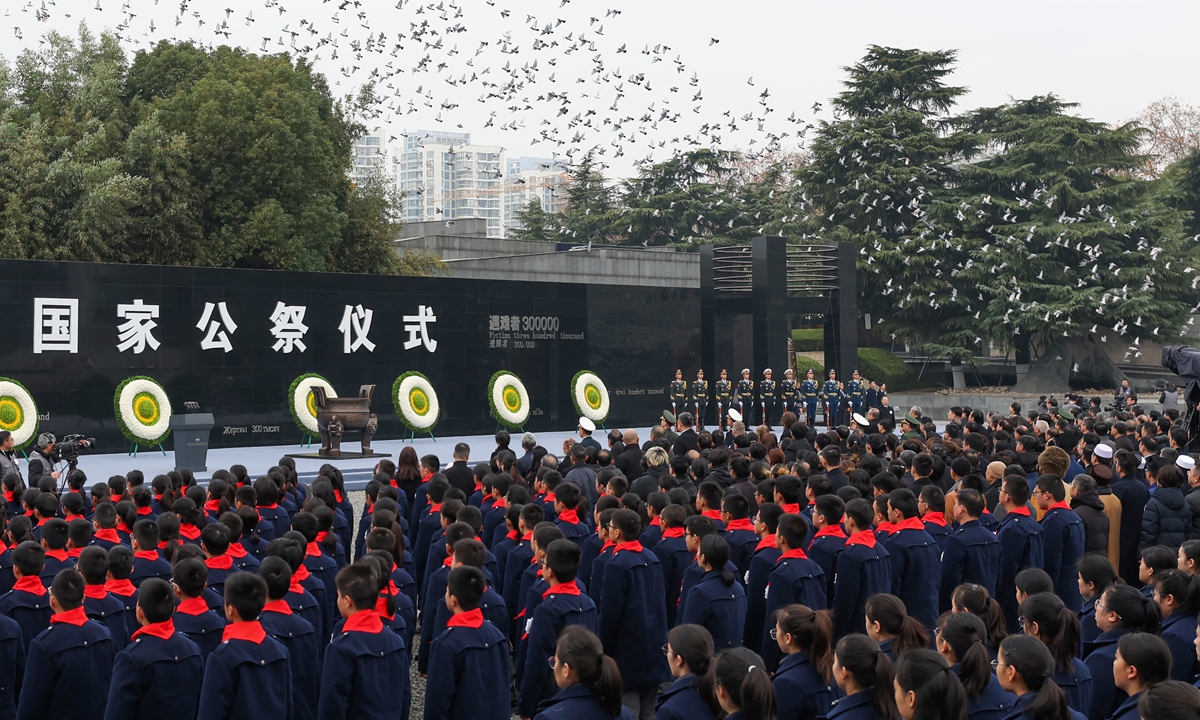China holds state commemoration for 300,000 victims of Nanjing Massacre
Painful memory reminds people to build nation, cherish peace

A memorial ceremony is held to mourn the 300,000 victims of the Nanjing Massacre at the Memorial Hall of the Victims in Nanjing Massacre by Japanese Invaders in Nanjing, East China's Jiangsu Province, on December 13, 2023. Photo: VCG
China held its 10th national memorial ceremony on Wednesday to mourn the 300,000 victims of the Nanjing Massacre. During the day, former curator of the Memorial Hall of the Victims in Nanjing Massacre by Japanese Invaders called for the younger generation to remember the painful memories and dedicate themselves to contributing to the development of the nation.
Early Wednesday morning, the national flag was flown at half-mast at the Memorial Hall of the Victims in Nanjing Massacre by Japanese Invaders in Nanjing. Then at exactly 10:01 am, blaring sirens initiated a complete standstill in Nanjing, capital of East China's Jiangsu Province.
Motorists in the downtown vicinity halted their vehicles and honked their horns, while pedestrians paused to observe a moment of silence as a tribute to the victims.
The Nanjing Massacre took place when Japanese troops captured the city on December 13, 1937. Over six weeks, they killed approximately 300,000 Chinese civilians and unarmed soldiers in one of the most barbaric episodes of World War II.
In order to remember the victims, the Shanghai Songhu Anti-Japanese War Memorial Hall specially launched an "online memorial ceremony" program to carry out online mourning activities, during which citizens could light virtual candles and express their condolences.
Students at Shanghai Shangde Experimental School recited "In the Name of Faith to the Future You," to memorialize the victims. The affectionate recitation enabled everyone to recall the history, and express the good wishes of young people in the new era to realize their dreams for China.
Though large snowflakes fell from the sky in Beijing, teachers and students at universities in the capital also held mourning activities at the Museum of the War of People's Resistance Against Japanese Aggression on Wednesday morning to remember the national heroes who gave their precious lives to achieve victory in the war.
The participants at the museum lined up neatly and sang the national anthem, after which a moment of silence was observed.
On Lugou Bridge in Beijing, where the Japanese imperialists provoked the Lugou Bridge Incident in 1937, and using this as the starting point to launch a long-premeditated all-out war on China, Zhang Yinghao, a veteran from North China's Hebei Province, told the Global Times, "Today is a day worth commemorating. Even though I can't be in Nanjing, I'm here where the war began amid this heavy snow to pay tribute to the memory of the martyrs in a unique manner. May we live in peace and may our motherland grow stronger."
"This event serves to reinforce the significance of this historical period and ensure that it is not forgotten, particularly by the younger generation. By keeping these painful memories alive, we are reminded of the war and national tragedy, which in turn motivates and empowers youth to contribute to the nation's development and work toward building a community with a shared future for mankind, which also calls for lasting peace, Zhu Chengshan, former curator of the Memorial Hall of the Victims in Nanjing Massacre by Japanese Invaders, told the Global Times on Wednesday.
Zhu noted that Wednesday marked the 10th national memorial day for the victims of the Nanjing Massacre and that sirens were sounded across Nanjing 10 times, while more and more international friends have noticed the memorial day and joined China to call for peace. At Wednesday's memorial ceremony in Nanjing, Zhu said he had noticed the presence of friends from the US, Japan and Malaysia.
"Both Chinese and foreigners share a common goal of desiring peace and sustainability. It is crucial to prioritize peace, especially in light of the ongoing conflicts in Ukraine and Russia, as well as the war between Israel and Palestine, which have resulted in numerous casualties and injuries," Zhu noted.
What does 300,000 victims mean? It means that during the six-week human catastrophe, on average, every 12 seconds, a Chinese citizen was killed. The victims were fathers, mothers, husbands, wives, children, or entire families, the former curator said.
As of December 1, 12 survivors of the Nanjing Massacre died this year, and only 38 registered survivors of the Nanjing Massacre remain, according to Fujian Daily.
"With the establishment of the national memorial day, more and more people have begun to help Nanjing restore the jigsaw puzzle of historical facts," Zhou Feng, the current curator of the Memorial Hall of the Victims in Nanjing Massacre by Japanese Invaders, said. This year, the museum has collected 1,103 pieces (sets) of cultural relics and historical materials, including a "Military Diary" by the Japanese invaders, and a batch of original US newspapers published during the Nanjing Massacre.


